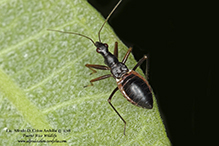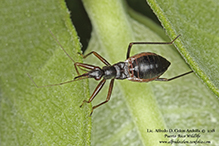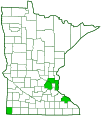Black damsel bug
(Nabis subcoleoptratus)
Conservation • Description • Habitat • Ecology • Distribution • Taxonomy
Conservation Status |
|||
| IUCN Red List | not listed |
||
| NatureServe | NNR - Unranked |
||
| Minnesota | not listed |
||
Description |
Black damsel bug is a small true bug. It is found in low on plants in fields and gardens across northern United States and adjacent Canadian provinces. It is common and locally abundant in Minnesota. The body is soft and somewhat ant-like in appearance, and late stage (instar) nymphs are ant mimics. Adults average ⅜″ (10 mm) long. The head, thorax, and abdomen are black and shiny. The head is narrowed into a distinct “neck” behind the eyes. There are two large compound eyes on the side of the head and two small simple eyes (occeli) on top of the head. The antennae are yellowish, thread-like, and long, more than half as long as the body. They have four segments. The basal segment (scape) is not twice as long as the head and is not abruptly thickened. The beak-like projection of the head that contains the piercing mouthparts (rostrum) is slender, yellowish, and has four segments. The exoskeletal plate covering the thorax (pronotum) has a wide, distinct collar at the end (nearest the head). The abdomen is in the shape of an elongated oval and is much wider than the thorax. Each abdominal section is enlarged laterally creating a continuous, flat, border (connexivum). The margins of the connexivum are yellowish. There are two pairs of wings. The forewings (hemelytra) on the mature adult are thickened, very short, and do not have a membranous section. The hindwings are thin, membranous, and concealed under the forewings. The legs are long, slender, and yellowish. They are not ringed. The third segment (femur) of the front legs is slightly enlarged. |
Size |
Total length: ⅜″ (10 mm) average |
Similar Species |
Habitat |
Fields |
Ecology |
Season |
Late May through August |
Behavior |
Despite their small size, damsel bugs are able to deliver a painful bite when harassed. |
Life Cycle |
Eggs overwinter. Late instar nymphs are ant mimics. |
Nymph Food |
|
Adult Food |
Plant bug (Miridae) nymphs |
Distribution |
||
|
Sources |
|
| 8/27/2025 | ||
Occurrence |
||
Widespread and abundant |
||
Taxonomy |
|
Order |
Hemiptera (True bugs, Hoppers, Aphids, and Allies) |
Suborder |
Heteroptera (True Bugs) |
Infraorder |
Cimicomorpha |
Superfamily |
Naboidea |
Family |
Nabidae (damsel bugs) |
Subfamily |
Nabinae |
Tribe |
Nabini |
Genus |
Nabis |
| Subgenus | Nabicula |
This species was formerly classified as Nabicula subcoleoptrata. The species Nabicula has been recently demoted to subgenus status, and this and other species were returned to the genus Nabis. |
|
Synonyms |
|
Nabicula subcoleoptrata |
|
Common Names |
|
black damsel bug |
|
Glossary
Connexivum
In Heteroptera: the enlarged, flattened margins of the abdomen. Plural: connexiva.
Femur
On insects and arachnids, the third, largest, most robust segment of the leg, coming immediately before the tibia. On humans, the thigh bone.
Hemelytron
The forewing of true bugs (order Hemiptera), thickened at the base and membranous at the tip. Plural: hemelytra.
Instar
The developmental stage of arthropods between each molt; in insects, the developmental stage of the larvae or nymph.
Ocellus
Simple eye; an eye with a single lens. Plural: ocelli.
Pronotum
The exoskeletal plate on the upper side of the first segment of the thorax of an insect.
Rostrum
The stiff, beak-like projection of the carapace or prolongation of the head of an insect, crustacean, or cetacean.
Scape
In plants: An erect, leafless stalk growing from the rootstock and supporting a flower or a flower cluster. In insects: The basal segment of the antenna.
Visitor Photos |
Share your photo of this insect. |
||
This button not working for you? |
||
Alfredo Colon |
||
 |
 |
|
MinnesotaSeasons.com Photos |
|

Slideshows |
|

Visitor Videos |
Share your video of this insect. |
||
This button not working for you? |
||
|
Other Videos |
|

|
Created: 7/1/2019 Last Updated: © MinnesotaSeasons.com. All rights reserved. |


